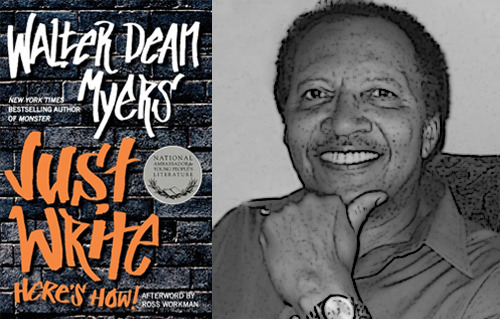Book Thoughts: Relatable, Action-Packed Writing Advice

“You can find inspiration everywhere. The trick is to keep your eyes open.” – Just Write: Here’s How!
I am a glutton for writing advice, and the most common tip I receive is “write what you know.” Personally, I find that a bit vague; if I only wrote about what I truly know of the banality of daily life, I’d have a pretty boring book on my hands.
Few advice-givers take the difficulty of crafting action into account, and this might be my favorite thing about Walter Dean Myers’ book, Just Write: Here’s How! Yes, he guides his readers towards writing about topics that are familiar to them (with good reason!), but he also gives specific and detailed descriptions of how to turn that boring high school fitness test into an emotional turning point for the main character.
Myers starts us off with a short and descriptive chapter on his evolution into a writer. However, rather than reading like a simple autobiography, this chapter offers a personal glimpse into his interests as a person and, correspondingly, as an author. Seeing how he aligns his life experience with his writing is a great tool for learning how to apply my own seemingly random life experiences with my fiction.
You see, I started reading this book in the midst of facilitating a weeklong personal-writing workshop for Oakland-based high school seniors applying to college. Going into it, I thought it would only interfere with my Camp novel, and I was resigned to failing in Week 2. But with a little thought and inspiration from both the kids I was working with, and Myers’ book, I changed my original, semi-boring idea into a more emotionally engaging story about a college freshman.
It may not be the literary masterpiece I was hoping for, but it’s something I and many others have experienced. It’s also something other people might actually be interested in reading, and I hope to turn it into something that the college freshman I was with would appreciate.
Myers mentions how he is always “keeping [his] mind open to ways to make [the] scene breakdown richer” when he is out and about in the world: be it shopping, driving, or just going for a walk around the neighborhood, he makes the fantastic point that incorporating multiple actions into one scene creates a depth and interest that just doesn’t exist with plain dialogue. While this usually sounds easier than it actually is, Myers lays it out in an almost mathematical fashion.
Throughout the book, he includes his actual writing notes and outlines demonstrating his process of expanding individual plot points into scenes that include dialogue, description, and energy. For a novice like myself, this proved invaluable. I know how to craft an outline for an academic paper, but I quickly learned that I needed a different technique for long fiction, and I used a couple of Myers’ outlines to make some short ones for my own novel.
I could go on about the 15 short writing tips in the back of the book (ten written by Myers himself, five written by his teen writing partner, Ross Workman), or the chapter-by-chapter breakdown of crafting a plot outline, but I’ll let you discover those for yourself!
— Shelby
Chris Baty's Blog
- Chris Baty's profile
- 63 followers



